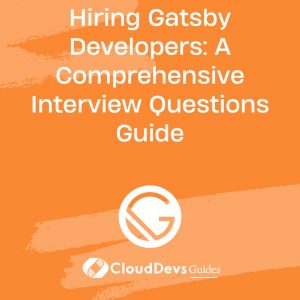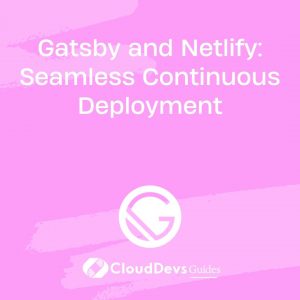Hiring Gatsby Developers: A Comprehensive Interview Questions Guide
In the dynamic world of modern web development, Gatsby has emerged as a powerful framework for building blazing-fast and feature-rich websites. To navigate the process of hiring Gatsby developers effectively, this guide equips you with essential interview questions and strategies to identify top-tier candidates with the technical expertise, problem-solving acumen, and Gatsby proficiency your team requires.
Table of Contents
1. How to Hire Gatsby Developers
Commence your journey of hiring Gatsby developers with these strategic steps:
- Job Requirements: Define specific job prerequisites outlining the desired skills and experience for your Gatsby development role.
- Search Channels: Utilize job boards, online platforms, and web development communities to discover potential Gatsby developer candidates.
- Screening: Evaluate candidates based on their Gatsby proficiency, previous front-end development experience, and supplementary skills.
- Technical Assessment: Develop a comprehensive technical evaluation to assess candidates’ coding abilities, familiarity with GraphQL, and problem-solving capabilities.
2. Key Skills to Look for in Gatsby Developers
When evaluating Gatsby developers, prioritize these core skills:
- Gatsby Proficiency: A deep understanding of Gatsby’s architecture, components, and features for building high-performance websites.
- React Expertise: Proficiency in React, as Gatsby is built on React and requires a strong grasp of its concepts and components.
- GraphQL Knowledge: Familiarity with GraphQL for querying data efficiently and using Gatsby’s GraphQL APIs for data sourcing.
- Web Performance Optimization: Experience in optimizing website performance through techniques such as lazy loading, code splitting, and image optimization.
- Responsive Design: Knowledge of responsive design principles and CSS frameworks for creating visually appealing and accessible web experiences.
- Version Control: Proficiency in using version control systems like Git to collaborate effectively with team members on codebases.
3. Gatsby Developer Hiring Process Overview
Here’s a high-level overview of the Gatsby developer hiring process:
- 3.1 Define Job Requirements and Skillsets
Lay a strong foundation by outlining clear job requirements, specifying the skills and experience you’re seeking in Gatsby developer candidates.
- 3.2 Craft Compelling Job Descriptions
Create captivating job descriptions that accurately convey the responsibilities and opportunities associated with the Gatsby development role.
- 3.3 Develop Gatsby Developer Interview Questions
Design a comprehensive set of interview questions covering Gatsby intricacies, React expertise, GraphQL proficiency, and front-end technologies.
4. Sample Gatsby Developer Interview Questions and Answers
Explore these sample questions and answers to assess candidates’ Gatsby skills:
Q1. Explain the purpose of Gatsby in modern web development. How does it contribute to website performance and SEO?
A: Gatsby is a static site generator that combines React, GraphQL, and modern build tools to create fast and SEO-friendly websites. It pre-renders pages into static HTML files, enhancing load times and optimizing SEO.
Q2. Describe the process of setting up a Gatsby project. What are the essential configuration files and directories involved?
A: To set up a Gatsby project, you’d begin by installing the Gatsby CLI and creating a new project using the CLI. Essential configuration files include gatsby-config.js, gatsby-node.js, and gatsby-browser.js. The src directory contains the project’s source files.
Q3. Implement a GraphQL query in Gatsby to fetch and display the titles of all blog posts.
import React from 'react'
import { graphql } from 'gatsby'
const BlogPage = ({ data }) => {
const posts = data.allMarkdownRemark.edges
return (
<div>
<h1>Blog Posts</h1>
<ul>
{posts.map(post => (
<li key={post.node.id}>{post.node.frontmatter.title}</li>
))}
</ul>
</div>
)
}
export const query = graphql`
query {
allMarkdownRemark {
edges {
node {
id
frontmatter {
title
}
}
}
}
}
`
export default BlogPage
Q4. What is Gatsby Node API? How can it be used to create dynamic pages or modify GraphQL queries?
A: The Gatsby Node API allows developers to customize various aspects of the Gatsby build process, such as creating dynamic pages from data sources, modifying GraphQL queries, and creating slugs for content nodes.
Q5. Describe the purpose of Gatsby plugins. How can you install and configure a plugin in a Gatsby project?
A: Gatsby plugins are reusable packages that enhance a Gatsby site’s functionality. They can provide data sources, transform data, optimize images, and more. To install a plugin, you’d use npm or yarn, and configure it in the gatsby-config.js file.
Q6. Explain the concept of Gatsby Themes. How can they be used to share functionality across multiple Gatsby projects?
A: Gatsby Themes allow you to package up functionality, styling, and components into a shareable and reusable module. Themes can be used to create consistent styles, layouts, and features across multiple Gatsby projects without duplicating code.
Q7. Write a Gatsby component that uses the useStaticQuery hook to fetch and display the site’s title from gatsby-config.js.
import React from 'react'
import { useStaticQuery, graphql } from 'gatsby'
const SiteTitle = () => {
const data = useStaticQuery(graphql`
query {
site {
siteMetadata {
title
}
}
}
`)
return <h1>{data.site.siteMetadata.title}</h1>
}
export default SiteTitle
Q8. What is Gatsby’s approach to image optimization? How can you use Gatsby’s Image component to display optimized images?
A: Gatsby offers automatic image optimization through plugins like gatsby-image. The Gatsby Image component allows developers to seamlessly display responsive images with lazy loading, WebP support, and automatic optimization.
Q9. Explain the concept of Gatsby SSR (Server-Side Rendering) and its benefits. When would you choose to use SSR in a Gatsby project?
A: Gatsby SSR involves rendering pages on the server side to improve performance and SEO. It’s particularly useful when content needs to be generated dynamically based on user requests or when data fetching requires authentication or complex logic.
Q10. How can you deploy a Gatsby site to production? Mention different deployment options and best practices.
A: Gatsby sites can be deployed to production using various platforms such as Netlify, Vercel, or traditional hosting services. To ensure a smooth deployment, optimize images, implement caching, and use continuous integration to automate build and deployment processes.
5. Hiring Gatsby Developers through CloudDevs
- Step 1: Connect with CloudDevs: Initiate a conversation with a CloudDevs consultant to discuss your Gatsby development project’s specifics, preferred skills, and desired experience levels.
- Step 2: Discover the Ideal Match: Within a short timeframe, CloudDevs presents you with meticulously selected Gatsby developers from their pool of pre-vetted professionals. Review their profiles and choose the candidate whose expertise aligns seamlessly with your project’s vision.
- Step 3: Commence a Risk-Free Trial: Engage in discussions with your chosen developer to ensure a smooth onboarding process. Once satisfied, formalize the collaboration and embark on a week-long free trial.
By leveraging the expertise of CloudDevs, you can seamlessly identify and hire top-tier Gatsby developers, ensuring your team possesses the skills necessary to craft
Table of Contents






